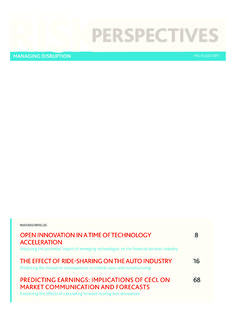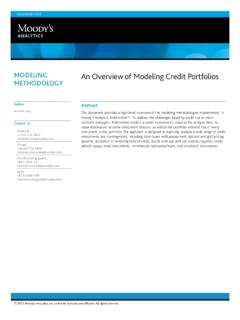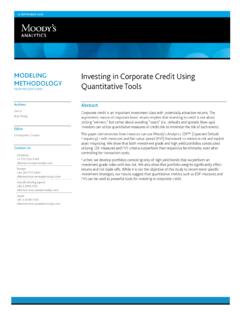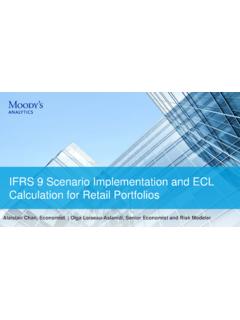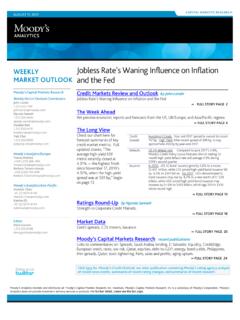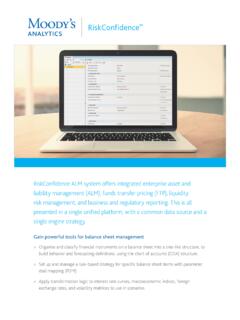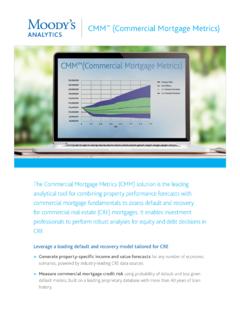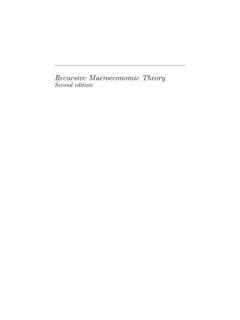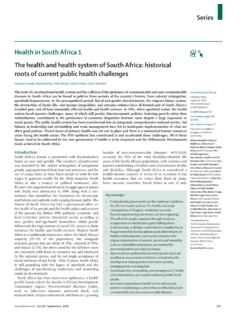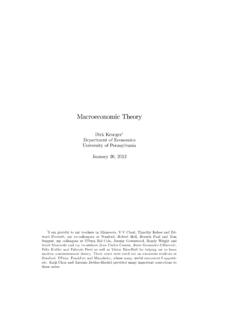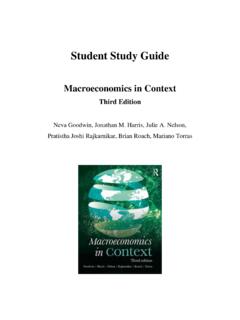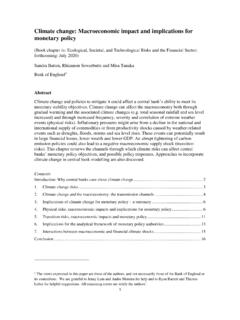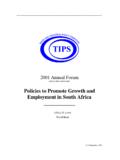Transcription of Macroeconomic Consequences of the Infrastructure ...
1 MOODY S ANALYTICSM acroeconoMic Consequences of the Infrastructure investMent and Jobs act & build back better fraMework 1 Macroeconomic Consequences of the Infrastructure Investment and Jobs Act & Build Back Better FrameworkINTRODUCTIONL awmakers in Washington DC continue to work feverishly on another massive fiscal plan, including a more than $1 trillion bipartisan Infrastructure deal and a $ trillion package of social spending and tax breaks to lower- and middle-income households that the Biden administration and congressional Democrats hope to pass into law via the budget reconciliation process. While the legislation remains in flux, it is similar in spirit to the Build Back Better agenda President Biden proposed earlier this year. If this is close to what becomes law, it will strengthen long-term economic growth , the benefits of which would mostly accrue to lower- and middle-income Americans.
2 The legislation is more-or-less paid for on a static basis and more than paid for on a dynamic basis through higher taxes on multinational corporations and the well-to-do and a range of several other pay-fors. Concerns that the plan will ignite undesirably high inflation and an overheating economy are overdone, as the fiscal support it provides will ensure the economy only returns to full employment from the recession caused by the COVID-19 pandemic. Because the package includes a myriad of spending and tax initiatives, some of which are new and uncertain, implementing this legislation as intended and in a timely way will take deft governance. In this white paper, we assess the Macroeconomic impact of both the bipartisan Infrastructure deal legislation and the reconciliation package of social spending and tax NOVEMBER, 2021 Prepared byMark EconomistBernard DirectorContact (London)+ (Prague)
3 Asia/Pacific + Others+ S ANALYTICSM acroeconoMic Consequences of the Infrastructure investMent and Jobs act & build back better fraMework 2 Macroeconomic Consequences of the Infrastructure investment and Jobs act & build back better frameworkBY MARK ZANDI AND BERNARD YAROSL awmakers in Washington DC continue to work feverishly on another massive fiscal plan,1 including a more than $1 trillion bipartisan Infrastructure deal and a $ trillion package of social spending and tax breaks to lower- and middle-income households that the Biden administration and congressional Democrats hope to pass into law via the budget reconciliation process. While the legislation remains in flux, it is similar in spirit to the Build Back Better agenda President Biden proposed earlier this year.
4 If this is close to what becomes law, it will strengthen long-term economic growth , the benefits of which would mostly accrue to lower- and middle-income Americans. The legislation is more-or-less paid for on a static basis and more than paid for on a dynamic basis through higher taxes on multinational corporations and the well-to-do and several other pay-fors (see Chart 1). Concerns that the plan will ignite undesirably high inflation and an overheating economy are overdone, as the fiscal support it provides will ensure the economy only returns to full employment from the recession caused by the COVID-19 pandemic. Because the package includes a myriad of spending and tax initiatives, some of which are new and uncertain, implementing this legislation as intended and in a timely way will take deft governance.
5 In this white paper, we assess the Macroeconomic impact of both the bipartisan Infrastructure legislation and the reconciliation package of social spending and tax Investment and Jobs ActThe Infrastructure Investment and Jobs Act, which has bipartisan support, includes more than $1 trillion in transportation and other physical Infrastructure spending over the decade 2022 to 2031, of which close to $600 billion is additional funding (see Table 1). Spending on roads and bridges, power systems, rail, broadband, water systems, and public transit gets the largest help pay for the legislation, lawmak-ers have pieced together several pay-fors, ranging from a delay in a rule affecting the treatment of drug rebates to an extension of the higher mortgage guarantee fees charged by Fannie Mae and Freddie Mac.
6 The legislation adds modestly to budget deficits over the 10-year budget horizon on a static basis, but meaningfully less so on a dynamic basis, as the increased infrastruc-ture spending supports stronger economic growth , which in turn generates more tax revenues and reduces other government spending on income support programs such as unemployment Infrastructure investment has significant Macroeconomic benefits. Near term it has a large so-called multiplier the increase in GDP for a dollar increase in in-vestment. It is among the highest compared with other types of federal government spending and tax Long term, eco-nomic research is in strong agreement that public Infrastructure provides a significantly positive contribution to GDP and employ-ment. It lowers business costs and thus improves competitiveness and productivity, allows workers to live closer to where they work, and thus reduces commute times, improves labor participation, and reduces carbon is more debate on whether public Infrastructure spending boosts GDP by as much as private capital does.
7 One reason for this is that, unlike private investment, federal investment is not driven solely by market forc-es or maximizing economic returns. Federal Infrastructure also has the goal of improving MOODY S ANALYTICSM acroeconoMic Consequences of the Infrastructure investMent and Jobs act & build back better fraMework 3quality of life, reducing inequities, supporting the work of the federal government itself, and addressing other objectives that policymakers may have. The federal government also impos-es various requirements that can increase the costs of the projects that it funds. We estimate the average return on private capital to be close to 10% that is, a $1 increase in private investment, all else being equal, increases GDP by 10 cents over a year while it is almost 7% for public so, this is an especially economically propitious time to increase public infrastruc-ture investment, since the return on that investment is substantially greater than the government s cost of financing given the ex-traordinarily low interest rates.
8 Thirty-year Treasury bond yields are close to 2%, while the return on almost any public Infrastructure project is likely to be meaningfully greater than Back Better frameworkThe $ trillion reconciliation package includes increased spending on various so-cial programs similar to those proposed in Biden s American Family Plan (see Table 2). There are substantial funds in the package for early childhood and higher education, child- and eldercare, housing, healthcare, and climate change mitigation. There are also substantial tax breaks for lower-in-come households, including an expansion of the earned income tax credit and an extension of the expanded child tax credit that was included as part of the American Rescue Plan passed into law in March; fam-ilies will stop getting monthly checks at year s end unless lawmakers extend help pay for the package, lawmakers are proposing higher taxes on multination-al corporations and well-to-do individu-als, and more reve-nues from closing the tax gap.
9 There is also a new 1% excise tax on share repurchases or a stock buyback tax. Companies buy back their stock to re-turn profits to share-holders and support their stock price. Repurchases have become increasingly popular among publicly traded companies and will total close to $800 billion this year. The package also raises meaning-fully savings from repealing the Trump ad-ministration s prescription drug rebate rule, which would have raised Medicare Part D program the particulars of the reconciliation package are still unsure, it is fair to say it is paid for, both on a static, and particularly on a dynamic This conclusion abstracts from the considerable uncertainties over the actual revenues that will be generated from such policies as closing the tax gap or implementing the new share repurchase tax.
10 There is also the possibility that policies in the package that are set to expire during the budget horizon (to ensure they do not add to deficits outside the horizon and violate budget reconciliation rules) would instead be extended given likely political pressure to continue funding. However, this does not necessarily mean that any future extension of these policies would not also be paid reconciliation package would provide a near-term boost to the economy given the tax cuts in the plan for lower-income indi-viduals and as spending on the various social programs gears up. It also would have several important long-term economic benefits. First, it would increase the labor force partic-ipation and hours worked of mostly lower-in-come women. It would do this by making childcare more affordable, and expanding the earned income tax credit that encourages low-income households to work.

